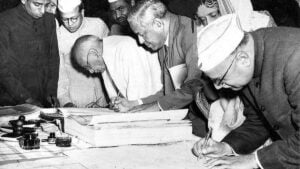The Government of India Act of 1935
Following the Nehru Report, the British government introduced The Government of India Act of 1935. It aimed to introduce constitutional reforms and self-government in British India while providing more governing powers to provinces.
It was the longest Act ever passed by the British Parliament and introduced a number of important changes, including:
- The establishment of a federal system of government, with a central government and provincial governments with assemblies.
- The introduction of direct elections to the provincial legislatures.
- The expansion of the franchise to include more Indians.
- The creation of a new post of Governor-General, who would have the power to veto legislation and suspend the provincial legislatures.
The Act also contained a number of safeguards for minorities, such as the reservation of seats in the legislatures for Muslims and other minority groups.
The Government of India Act 1935 was a significant step forward in the constitutional development of India. It paved the way for Indian independence in 1947.
While the act was a major step in India’s constitutional journey, its full application was delayed because of the pressing demands of World War II. This means that the Act’s provisions and changes couldn’t be fully put into practice during the war because the British colonial government was preoccupied with the war effort.
However, the Indians were not satisfied with these acts, as they did not give them enough autonomy and democracy. They also opposed the partition of India into two separate countries: India and Pakistan. They wanted a united and independent India with a federal structure and a secular outlook.
In 1946, the British government agreed to grant independence to India. The British government appointed a Cabinet Mission to India to work with the Indian leaders to draft a constitution for the newly independent country.
The demand for a Constituent Assembly became stronger after the Second World War when the British government announced its intention to grant independence to India. However, there were differences between the Congress and the Muslim League, another major political party representing the interests of the Muslim community, over the composition and powers of the Constituent Assembly. The Muslim League wanted a separate Constituent Assembly for the Muslim-majority areas of India, which later became Pakistan.
The British government tried to resolve the deadlock by sending three missions to India: the Cripps Mission in 1942, the Wavell Plan in 1945, and the Cabinet Mission in 1946. The Cabinet Mission Plan was the most successful one. It also proposed a Constituent Assembly to draft a constitution for India, with members elected indirectly by the provincial assemblies using a single transferable vote system, i.e. voters rank candidates in order of preference. In such a system, the candidate with the highest first preference will win the election.

The Constitution of India being signed by Members of the Constituent Assembly in January 1950. | Photo Credit: The Hindu Archives
The Cabinet Mission Plan of 1946
In September 1945, the new Labour government in Britain decided to create a Constituent Assembly for India. The Cabinet Mission was sent to India in March 1946 to help establish this Assembly.
The Mission faced a major challenge: the two main political parties, the Indian National Congress and the Muslim League had very different ideas about India’s future. The Muslim League wanted the Muslim-majority provinces of India to form a separate country called Pakistan, while the Congress wanted a united India.
The Mission tried to help the two parties reach an agreement at a conference in Shimla, but this was unsuccessful. The Mission then released its own proposals, known as the Cabinet Mission Plan.
The Cabinet Mission Plan of 1946 proposed a three-tier structure for the governance of India:
- Central government: The central government would be responsible for foreign affairs, defense, and communications.
- Provincial governments: The provincial governments would be responsible for all other subjects.
- Groups of provinces: The provinces would be grouped together into three groups: Group A, Group B, and Group C. Each group would have its own executive and legislature.
The three groups of provinces were as follows:
- Group A: This group would comprise the Hindu-majority provinces of Madras, Bombay, Central Provinces and Berar, and the United Provinces.
- Group B: This group would comprise the Muslim-majority provinces of Punjab, North-West Frontier Province, and Sindh.
- Group C: This group would comprise the Muslim-majority province of Bengal and the Hindu-majority province of Assam.
The groups of provinces would have the power to legislate on certain subjects, such as education, agriculture, and public health. The central government would have the power to veto legislation passed by the groups of provinces.
The Cabinet Mission Plan also proposed that the Constituent Assembly of India be convened to draft a constitution for India. The Constituent Assembly would be elected by the provincial legislatures, and each group of provinces would have equal representation in the Constituent Assembly.
The Cabinet Mission Plan was rejected by the Muslim League, but it was accepted by the Indian National Congress. The plan was eventually abandoned due to the failure of the Indian National Congress and the Muslim League to agree on the grouping of provinces.
While the Cabinet Mission Plan was ultimately unsuccessful, it did play an important role in the process of Indian independence. The plan proposed a federal system of government for India, and it also proposed that the Constituent Assembly of India be elected on the basis of universal adult suffrage. These were both important principles that were incorporated into the Constitution of India.
After the independence of India and Pakistan on August 15, 1947 and August 14, 1947 respectively, The Constituent Assembly of India, which had been elected in 1946, began drafting the Constitution of India.
Continue to the next section: The Constituent Assembly of India
